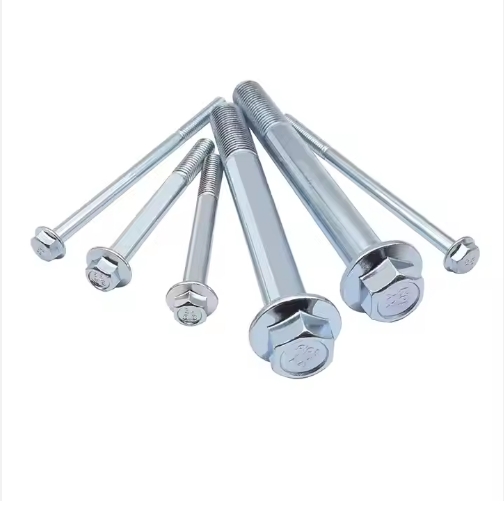Release time:2020-01-16 18:44 Browse:

### 1. **Material & Strength: Grade 8.8 High-Strength Steel**
- **Alloy Steel Composition**: Made from low-alloy steel (typically containing elements like carbon, manganese, and sometimes chromium or molybdenum) to enhance strength and hardenability. This base material undergoes precise heat treatment—quenching (rapid cooling from high temperatures) followed by tempering (controlled reheating)—to achieve the Grade 8.8 specification.
- **Mechanical Properties**: Confirms to international standards (e.g., ISO 898-1) with a minimum tensile strength of 800 MPa and yield strength of 640 MPa. This places it in the medium-high strength category, capable of withstanding heavy static and dynamic loads, making it suitable for critical structural or machinery applications where failure risk must be minimized.
### 2. **Design Features: Hexagonal Head & Half-Thread Configuration**
- **Hexagonal Head Design**: Features a six-sided, flat-topped head with parallel flats, engineered for compatibility with standard wrenches, sockets, or torque tools. The head’s width across flats (WAF) and height are standardized to ensure consistent engagement, allowing for uniform torque application and reducing the risk of slippage during installation or removal.
- **Half-Thread Structure**: The bolt shank is partially threaded—only the lower section (typically 2/3 of the total length, depending on size) features precision-cut threads, while the upper section remains unthreaded. This design balances two key functions:
- The threaded portion ensures secure, tight engagement with nuts or tapped holes, distributing clamping force effectively.
- The unthreaded shank (also called the “grip length”) enhances shear resistance, as the solid steel section better withstands lateral or twisting forces compared to threaded areas, which are more prone to stress concentration.
### 3. **Extended External Screw Rod: Versatility in Reach**
- **Longer Rod Length**: The “extended” designation means the screw rod (shank) is longer than standard bolts of the same diameter, providing increased reach for fastening through thick materials, multi-layer components, or deep assemblies. For example, in construction, this allows securing thick steel plates, concrete formwork, or machinery with deep mounting points.
- **Dimensional Consistency**: The extended rod maintains uniform diameter throughout its length (excluding the threaded section), ensuring structural integrity even when spanning large gaps. This consistency prevents weak points that could fail under load.
### 4. **Surface Treatment: Galvanizing for Corrosion Resistance**
- **Galvanization Process**: Coated with a layer of zinc via either hot-dip galvanizing (immersing the bolt in molten zinc) or electro-galvanizing (electrochemically depositing zinc). Hot-dip galvanizing produces a thicker, more durable coating (typically 45-85 μm), while electro-galvanizing offers a thinner, smoother finish (5-25 μm) for applications where precision fit is critical.
- **Protective Benefits**: The zinc coating acts as a sacrificial barrier—zinc corrodes preferentially to steel, shielding the underlying high-strength material from rust, moisture, and chemical exposure. This makes the bolts suitable for outdoor use (e.g., infrastructure, bridges), humid environments (e.g., factories, water treatment plants), or areas with mild chemical contact (e.g., agricultural equipment).
### 5. **Size Range & Practical Applications**
- **Diverse Sizes**: Available in a wide range of diameters (e.g., M6 to M30 in metric, or 1/4” to 1” in imperial) and extended lengths (often exceeding standard bolt lengths by 50% or more, depending on diameter). This variety ensures compatibility with specific project requirements, from small machinery to large-scale construction.
- **Typical Use Cases**:
- **Structural Engineering**: Securing steel beams, brackets, or load-bearing frames in buildings, bridges, or industrial facilities.
- **Heavy Machinery**: Mounting engines, gearboxes, or hydraulic systems, where high strength and corrosion resistance prevent loosening or failure under vibration.
- **Infrastructure Projects**: Fastening guardrails, signposts, or utility poles in outdoor environments, where the extended rod accommodates thick or multiple layers of material.
- **Manufacturing**: Assembling large equipment (e.g., presses, conveyors) where extended reach and reliable clamping force are essential for operational safety.

